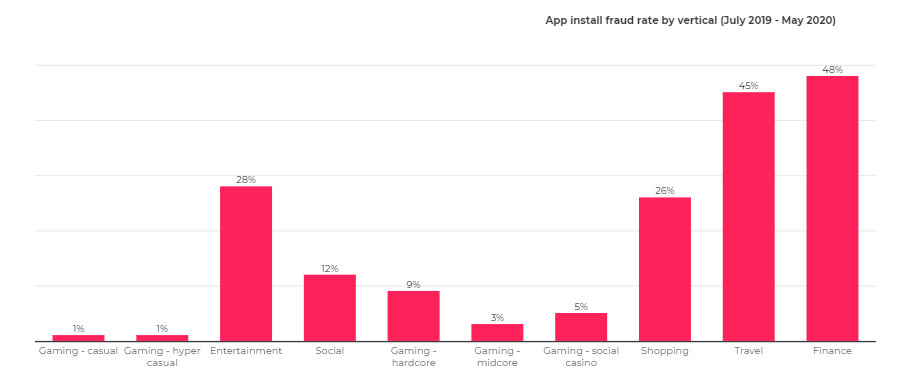Mobile app fraud remains a significant threat, costing the industry billions of dollars annually. Despite considerable efforts to combat it, fraudsters relentlessly seek new ways to exploit the system. The pandemic-driven surge in app usage in early 2020 provided a fertile ground for these bad actors.
To grasp the magnitude of mobile app fraud’s evolution, a historical perspective is revealing. Five years ago, industry reports estimated fraud losses at a few hundred million dollars annually. The exponential increase to today’s billions underscores not just the growth of the digital economy but the escalating sophistication of fraudsters. This historical context illustrates the relentless pace at which these malicious actors adapt, making ongoing vigilance and innovation in fraud prevention methods essential.
The fight against mobile app fraud continues to evolve, with recent reports revealing new trends and challenges. AppsFlyer’s 2023 report, analyzing 22 billion installs, showed a 40%+ increase in fraud in the latter half of 2022. This comprehensive analysis provided insights into fraud trends across platforms, categories, and countries, highlighting the persistent and evolving nature of install fraud.
iOS vs. Android: Which Has Better Fraud Protection?
iOS maintains its lead in fraud protection, but Android’s larger market share and global reach offer a wider playing field for fraudulent activities, resulting in a higher fraud rate. While iOS boasts superior in-built security features, such as app sandboxing and strict app review processes, Android’s open ecosystem offers greater flexibility at the expense of increased exposure to malicious apps. This distinction is crucial for developers and marketers when designing fraud prevention strategies.
For Android, employing additional layers of security, such as app integrity checks and anomaly detection systems, can mitigate risks. Conversely, for iOS, focusing on data privacy compliance and leveraging Apple’s latest security updates ensures protection remains robust. However, most apps now have robust protections due to heightened fraud awareness, although sophisticated fraudsters continue to exploit vulnerabilities.
Apps at Greatest Risk of Install Fraud
Contrary to expectations, finance, travel, shopping, and entertainment apps face higher install fraud risks compared to gaming apps. This is due to their higher cost per install (CPI) rates and larger budgets, making them lucrative targets for fraudsters, despite gaming apps employing advanced anti-fraud tools.


Image: AppsFlyer
Common Mobile App Fraud Methods
The various methods employed by fraudsters, such as automated scripts, account takeovers, and click flooding, underscore the complex and multifaceted nature of mobile app fraud. Understanding these common tactics is crucial for developing effective strategies to combat fraud and protect your advertising investments.
Automated Scripts (Bots)
Cybercriminals frequently employ bots as their go-to tool for executing fraud. These bots can be programmed to download apps at inhuman speeds, complete in-app tutorials in unrealistic sequences, or navigate app interfaces in ways that deviate from normal user behavior. Their capability to operate at a large scale and with speed makes them particularly damaging, as they can inflate user engagement metrics and skew analytics data significantly.
Account Takeovers (Hijacking)
Account takeovers, or hijacking, are commonly observed in the gaming sector. Alongside, click flooding emerges as a crafty strategy, where fraudulent entities generate an excessive number of clicks. This tactic aims to falsely attribute the last click to themselves prior to an app’s installation, despite not contributing to the user’s decision to download the app.
Click Flooding
Click flooding involves using automated scripts or compromised devices to generate a massive number of clicks on app install links, often originating from irrelevant sources like unrelated websites or low-quality ad networks. This manipulates attribution models, allowing fraudsters to profit from organic installations without contributing to them. Such activity inflates engagement metrics, complicating accurate campaign measurement and digital advertising integrity.
The Growing Threat of Mobile Malware
Mobile malware remains a significant concern, with fraudsters using tactics like app masking and leveraging suspicious apps outside official marketplaces. App masking is a technique where fraudsters disguise malicious apps to appear legitimate. They might steal the icon and name of a popular app, making it difficult for users to distinguish between the real and fake appThese pose red flags for fraud detection systems, emphasizing the need for robust security measures.
The Financial Impact of Mobile App Fraud
Mobile app fraud’s financial implications are staggering, with estimated global losses reaching billions of dollars annually. For businesses, the costs extend beyond direct financial losses, encompassing wasted ad spend, skewed performance metrics, and damaged brand reputation. Investing in robust fraud prevention measures is crucial to mitigate these impacts and protect long-term growth.
The financial implications of mobile app fraud are far-reaching, extending beyond the immediate monetary losses. Businesses also face the consequences of diminished return on investment (ROI) and compromised analytics, which can hinder their ability to make informed decisions and optimize their strategies. Compromised analytics can lead to a distorted view of an app’s performance, causing businesses to make misguided decisions based on inaccurate data. For instance, fraudulent installs and engagement metrics may inflate the perceived success of a campaign, leading to increased investment in ineffective strategies.
Conversely, genuine user interactions may be overshadowed by fraudulent activity, causing businesses to undervalue the impact of legitimate marketing efforts. In the long run, these misleading insights can result in suboptimal resource allocation, hindered growth, and a competitive disadvantage in the market. These ripple effects underscore the urgent need for effective countermeasures to protect digital assets and maintain the integrity of the mobile app ecosystem.
Mobile Ad Fraud Trends and Future Expectations
The AppsFlyer report indicates an alarming increase in fraud attacks, underlining the importance of vigilance and proactive protection. The shift towards in-app fraud presents new challenges, requiring apps to run more campaigns focused on reducing churn and increasing retention. While the industry is unlikely to eliminate fraud entirely due to its complexity and profitability for fraudsters, collaborative efforts and advanced technologies offer hope.
As the mobile app industry evolves, so do the technologies at its disposal to combat fraud. Blockchain technology, for instance, offers unprecedented transparency and security for in-app transactions, potentially revolutionizing how we approach fraud prevention. Similarly, advancements in AI and machine learning enable real-time fraud detection and predictive analytics, offering a proactive stance against fraudulent activities. Exploring these emerging technologies not only fortifies current defenses but also prepares us for future threats in the ever-evolving digital landscape.
Best Practices for Protecting Your App Against Fraud
Implementing Advanced Fraud Detection Solutions
Machine learning and AI have emerged as powerful tools in the fight against mobile app fraud. These technologies leverage vast amounts of data to identify patterns and anomalies indicative of fraudulent activity. By continuously learning from historical data and adapting to new fraud techniques, machine learning algorithms can detect sophisticated attacks that may evade traditional rule-based systems. However, implementing these advanced solutions requires significant resources and expertise, as well as ongoing monitoring and refinement to ensure their effectiveness. Despite these challenges, the benefits of machine learning and AI in fraud detection far outweigh the costs, enabling businesses to stay one step ahead of fraudsters and protect their advertising investments.
Monitoring and Analyzing App Data
Regularly monitoring and analyzing app install and engagement data is crucial for identifying anomalies that may indicate fraudulent activity. By establishing clear guidelines and thresholds for what constitutes suspicious behavior, businesses can quickly detect and respond to potential threats. This proactive approach allows for swift mitigation of fraudulent activities, minimizing their impact on the app’s performance and reputation.
Partnering with Trusted Ad Networks
Partnering with trusted ad networks that prioritize fraud prevention is another essential strategy for protecting your app. These networks employ sophisticated fraud detection technologies and have strict policies in place to ensure the quality and legitimacy of the traffic they deliver. By working with reputable ad networks, businesses can reduce their exposure to fraudulent activities and benefit from the network’s expertise in identifying and combating emerging threats.
Staying Informed and Adaptable
The mobile app fraud landscape is constantly evolving, with fraudsters continually developing new tactics to evade detection. To stay ahead of these threats, it is essential for businesses to stay informed about the latest fraud trends and adapt their defenses accordingly. This may involve regularly updating fraud detection algorithms, incorporating new data sources, and collaborating with industry partners to share knowledge and best practices.
Empowering Users in the Fight Against Fraud
While implementing technical fraud prevention measures is essential, user education and awareness also play a crucial role in mitigating the impact of mobile app fraud. By empowering users with the knowledge and tools to protect themselves, businesses can create a more secure ecosystem and reduce the likelihood of successful fraudulent attacks.
Promoting Secure App Downloads
Encouraging users to be cautious of suspicious apps and download only from official app stores is a critical best practice. Official app stores, such as the Apple App Store and Google Play Store, have strict guidelines and review processes in place to ensure the legitimacy and safety of the apps they offer. By educating users about the risks associated with downloading apps from untrusted sources, businesses can reduce the likelihood of users falling victim to fraudulent or malicious apps.
Encouraging Two-Factor Authentication
Enabling two-factor authentication is another essential best practice for users. This security measure adds an extra layer of protection to user accounts, requiring a second form of verification, such as a code sent to a mobile device, in addition to a password. By promoting the use of two-factor authentication, businesses can help users safeguard their accounts against unauthorized access and reduce the risk of account takeovers.
Fostering User Vigilance
Regularly monitoring accounts for unusual activity and promptly reporting any suspicious behavior is crucial for detecting and mitigating fraudulent activities. Businesses should encourage users to be vigilant and provide clear channels for reporting suspected fraud. By actively engaging users in the fight against fraud, businesses can foster a culture of security and build trust with their audience, ultimately enhancing the overall effectiveness of their fraud prevention efforts.
Promoting Strong Password Practices
Using strong, unique passwords and avoiding sharing them with others is another critical best practice for users. Weak or reused passwords make it easier for fraudsters to gain unauthorized access to user accounts, leading to account takeovers and other fraudulent activities. By educating users about the importance of strong password practices and providing tools such as password managers, businesses can empower users to take an active role in protecting their accounts and data.
Navigating the Regulatory Landscape and Forging Partnerships
In addition to technological solutions and user education, navigating the complex regulatory environment is paramount. Adherence to GDPR, CCPA, and other privacy laws not only ensures legal compliance but also builds user trust. By demonstrating a commitment to data privacy and security, businesses can foster a positive reputation and enhance user confidence in their app.
Moreover, forging partnerships with cybersecurity firms and participating in industry-wide anti-fraud initiatives can amplify efforts. Such collaborations foster a shared knowledge base, enhance detection methodologies, and create a united front against fraudsters. By working together, businesses can leverage collective expertise and resources to combat mobile app fraud more effectively, underscoring the adage that ‘together, we are stronger.’
In conclusion, protecting your app against fraud requires a multi-faceted approach that encompasses advanced technological solutions, user education and empowerment, regulatory compliance, and strategic partnerships. By implementing these best practices and fostering a culture of security, businesses can create a more resilient and trustworthy mobile app ecosystem, where innovation and growth can flourish unhindered by the threat of fraud.
Our Proactive Approach to Fighting Mobile App Ad Fraud
In the ever-changing mobile app landscape, ad fraud poses a significant threat. At AdAction, we combat this issue through a proactive, multi-faceted approach that utilizes cutting-edge technology, industry collaboration, and expert knowledge.
Our team works tirelessly to fight mobile app fraud. We employ advanced detection technologies and real-time monitoring to quickly identify and mitigate suspicious activities. Our commitment to industry cooperation is evident through our active role in the Coalition Against Ad Fraud (CAAF), where we collaborate with partners to develop robust solutions. We’ve been recognized for our efforts by earning a spot on the Singular ROI Global Fraud Leaders for Android list, which evaluates companies based on their ability to deliver high-quality, fraud-free traffic.
AdAction is dedicated to safeguarding the integrity and profitability of our clients’ campaigns. Our state-of-the-art tools and industry knowledge position us at the forefront of the battle against ad fraud. By partnering with AdAction, app developers and advertisers can have confidence that their investments are protected by the most effective fraud prevention measures available.
Together, we can create a safer, more secure mobile app ecosystem where innovation thrives. If you’re ready to take your app’s growth to the next level, our team is here to help. Contact us today to learn how AdAction can protect your app from fraud and unlock its full potential.


Nick is a seasoned digital marketing expert with multifaceted expertise across SEO, paid media, content marketing and data analytics. Leveraging the latest technologies, Nick future-proofs brands through integrated strategies that enhance their visibility and maximize ROI.


